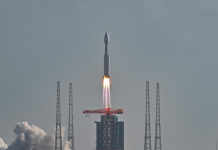BEIJING: Record-breaking passenger volumes have been reached as travelers return to their homes after the eight-day National Day and Mid-Autumn Festival holiday that ended on Wednesday, with both cross-regional travel and daily passenger flows hitting new highs, according to official data.
The Ministry of Transport estimates that 2.43 billion cross-regional trips were made between Oct 1 and Wednesday, averaging 304 million trips a day.
By mode of transport, railways were responsible for an estimated 153 million passenger trips, averaging 19.24 million a day, up 2.6 percent from a year earlier. Waterways saw 11.67 million, averaging 1.46 million daily, up 4.2 percent, while civil aviation handled 19.17 million, averaging 2.4 million daily, an increase of 3.4 percent.
The road network, including expressways and national highways, saw about 2.25 billion passenger trips, averaging more than 280 million a day — a 6.5 percent rise year-on-year, the ministry said on Wednesday.
The travel peak began on Oct 1, with 336 million cross-regional trips made nationwide — the highest figure on record for the same period. On that day alone, China’s railways handled 23.13 million passenger trips, setting a single-day record.
Major urban clusters such as the Beijing-Tianjin-Hebei region, the Yangtze River Delta, the Guangdong-Hong Kong-Macao Greater Bay Area, and the Chengdu-Chongqing economic circle were among the top destinations for travelers.
Transportation authorities said this year’s travel rush was marked by larger passenger volumes, smoother operations and improved service capacity across all transport modes. Many high-speed rail stations extended operating hours, opened additional security lanes and arranged overnight services to accommodate surging demand.
Self-driving remained the preferred travel option for many families. To ensure smooth journeys for new energy vehicles, local authorities expanded charging facilities and deployed mobile charging units along expressways.
In Hunan province, 144 new charging spaces were added across 31 expressway service areas, bringing the total to more than 1,380 charging spots — including 22 ultra-fast stations capable of adding 300 kilometers of range in five minutes. In Hubei province, expressway service areas added 219 mobile chargers and 2,100 extra staff, boosting charging capacity by more than 40 percent to handle a 60 percent rise in demand.
New infrastructure has also improved accessibility. On Sept 28, a new high-speed railway linking Shenyang, Liaoning province, and Baishan, Jilin province, opened, reducing travel time between Shenyang and the popular tourist destination Changbai Mountain from about three hours to less than two. –The Daily Mail-China Daily news exchange item






